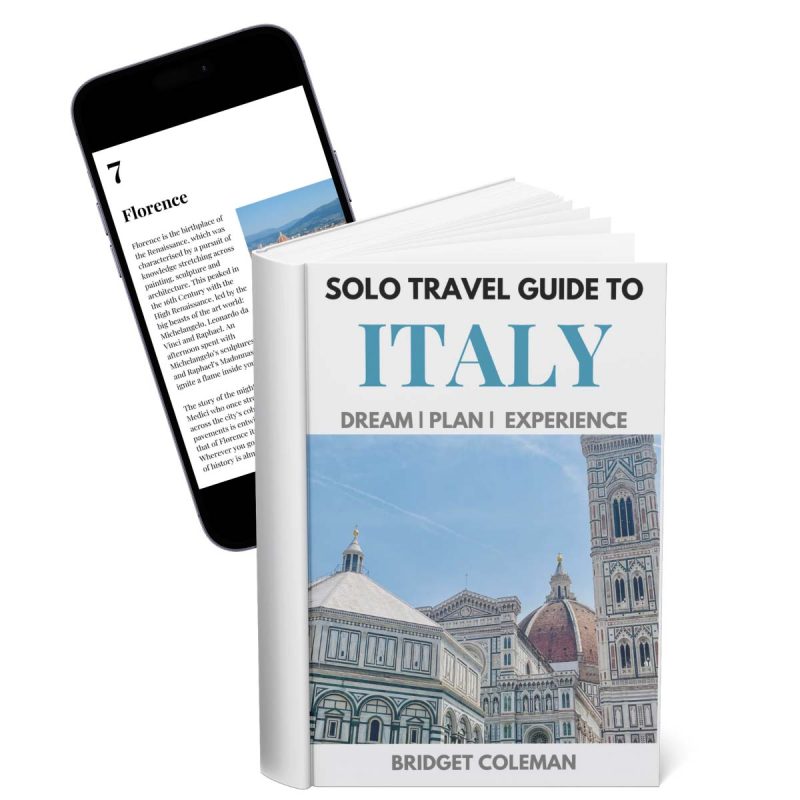Florence is the birthplace of the Italian Renaissance and home to some of the greatest works of art on the planet. From Michelangelo to Da Vinci, works from all of the artistic big hitters are hanging in the city’s churches, palaces and museums.
But which paintings should you include in your Florence art bucket list?
This is where I can help you. As a Renaissance fan girl and serial visitor to Florence, I’ve curated a shortlist of the paintings in Florence that you must see.
Can’t tell your Titians from your Botticellis? Join me on a journey through Renaissance art in Florence.
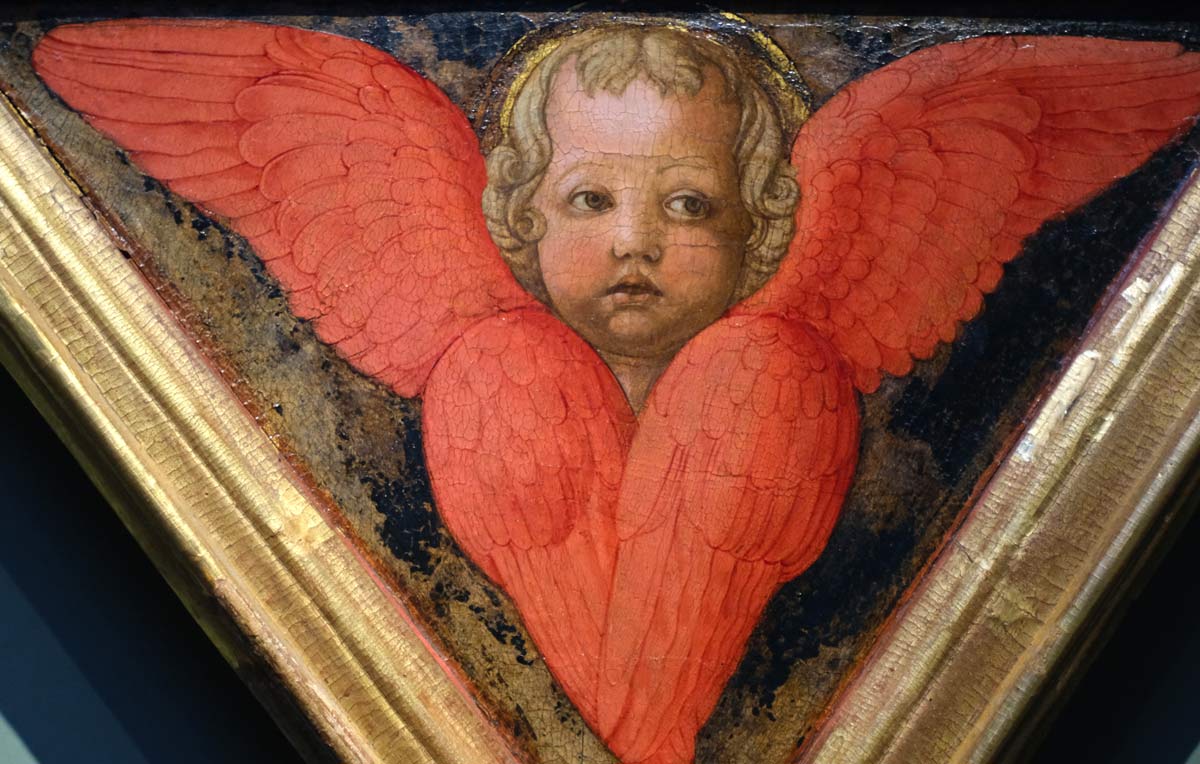
Some articles on this website contain affiliate links. This means that I may earn a small commission if you make a purchase through these links. As an Amazon Associate, I earn from qualifying purchases. Read the full disclosure here.
The Birth of Renaissance Art in Florence
The Renaissance – literal meaning “rebirth” – started in Florence in the 14th Century. At a time when much of Europe was mired in medievalism, Florence was booming, thanks to its bankers and trade merchants.
It reached its zenith in the 16th Century with the High Renaissance. This was led by the big three: Leonardo da Vinci, Raphael and Michelangelo.
These were optimistic times and the Renaissance was characterised by a dedicated pursuit of knowledge, stretching across painting, sculpture and architecture.
There was a move away from the existing two-dimensional “flat” style of painting to developing perspective and drawing from live models. This drew heavily on Greek and Roman Classical art.
Humanism was at its core. Man became the centre of focus with nature taking second place. Traditional religious subjects were the most common subject matter and were frequently commissioned by patrons.
I’VE WRITTEN THIS ITALY SOLO TRAVEL GUIDE!
A 100+ page ebook to inspire and equip solo travellers with the confidence and knowledge to explore Italy independently
- Plan Your Trip – with curated itineraries, budgeting and how to get around
- Explore Awesome Destinations – guides to the must-see cities of Rome, Florence, Venice and Naples
- Stay Safe as a Solo Traveller – practical safety advice, empowering you to confidently navigate Italy and avoid common pitfalls
- Enjoy Eating Out in Italy – essential tried-and-tested solo dining tips
Paintings in the Uffizi Galleries
Many of the most famous art in Florence are hung on the walls of the Ufizzi. If you are short on time, I recommend prioritising these paintings as they will walk you through the development of Renaissance Art.
Occupying the first and second floors of a large 16th-century building designed by Giorgio Vasari, the Uffizi is home to the greatest collection of Italian art in the world. Whether you are spending a day in Florence or a week here, visiting this gallery is unmissable, even if you only have a passing interest in art.
Let’s trace the evolution of the Renaissance through these important works of art in roughly chronological order, echoing the layout of the gallery.
Madonna and Child, Giotto (1310)
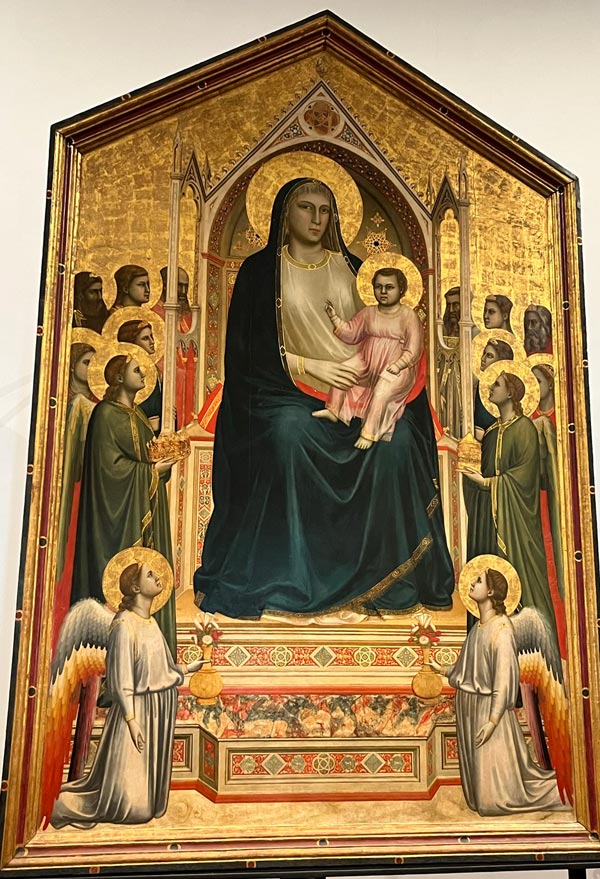
The importance of Giotto (1267 – 1337) in the development of Renaissance art in Italy cannot be overestimated. Mainly active in Florence, he was instrumental in freeing Italian painting from the two-dimensional Byzantine style of the early Middle Ages.
If you want a sneak preview of the Renaissance, visit Padua to see his frescoes in the Scrovegni Chapel.
Giotto’s Madonna and Child is one of the first stabs at realism in depicting this popular religious subject.
Mary and her bambino sit on a canopied throne with angels in front and prophets behind, lending it a three-dimensional quality. The steps leading up to the throne almost extend into our world, enveloping us in the scene.
But look at Mary herself. She is painted like a Classical statue, a revolutionary departure from the usual medieval representations.
It’s a cheeky preview of Renaissance art a hundred years before it took off.
Annunciation with St. Margaret and St. Ansanus, Simone Martini (1333)
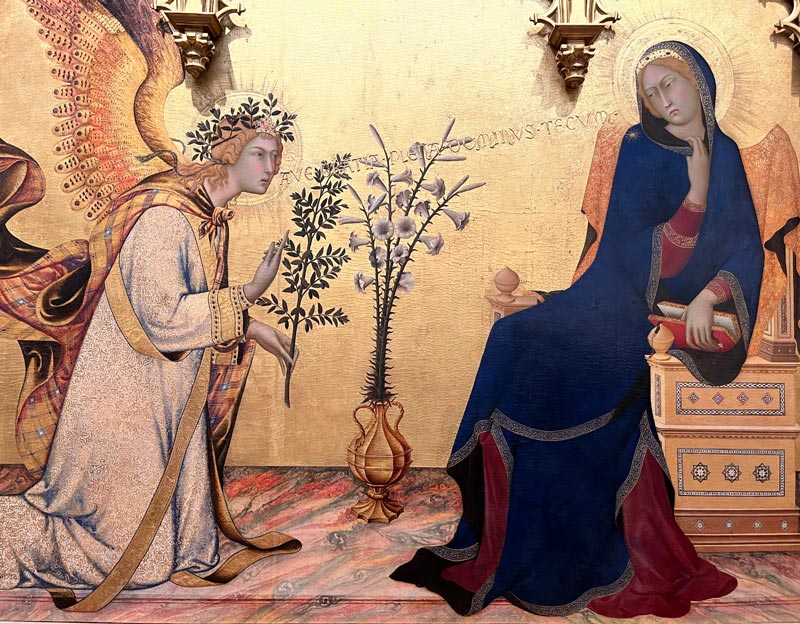
Siena-born Simone Martini (1284 – 1344) was a major figure in the development of early Italian art and an important exponent of the Gothic style of painting. Martini did more than any other artist to spread the influence of Sienese painting.
The Annunciation is his masterpiece and is not only one of the most outstanding works of Gothic painting but is also one of the greatest artworks in history. This wooden triptych, painted in tempura and gold, was commissioned for a side altar in Siena Cathedral.
It is a typical medieval work, characterised by a gilded background, a two-dimensional feel and meticulous detail. Realism is not the order of the day here.
Mary is not the beautiful Mary or serene Mary that we see in later paintings. She is a generic woman whose holiness and purity are symbolised by her halo and the vase of lilies.
I have to say that she appears less than thrilled by the appearance of the angel.
Battle of San Romano, Paolo Uccello (1435)
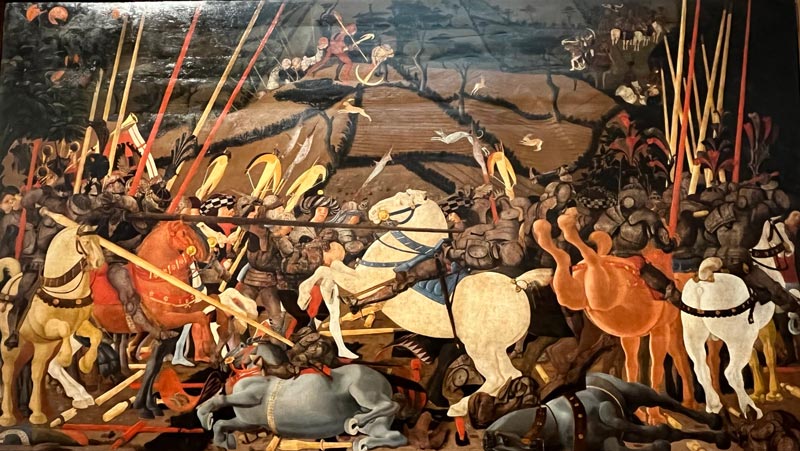
Paolo Uccello (1397 – 1475) may not be a familiar name, but this Florentine painter was one of the pioneers of linear perspective in art. It is said that this was his obsession, and he would burn the midnight oil trying to grasp the exact vanishing point.
This is one of three paintings that celebrate the victory of the Florentines over the Sienese troops at the battle of San Romano in 1432.
What marks out this large canvas is that it is one of the first attempts at linear perspective. Uccello experiments with a technique known as foreshortening, making figures appear as if they are receding into the distance.
It’s not an unqualified success – some of the proportions look odd – but it marks an important point in art history.
Madonna and Child with Two Angels, Filippo Lippi (1465)
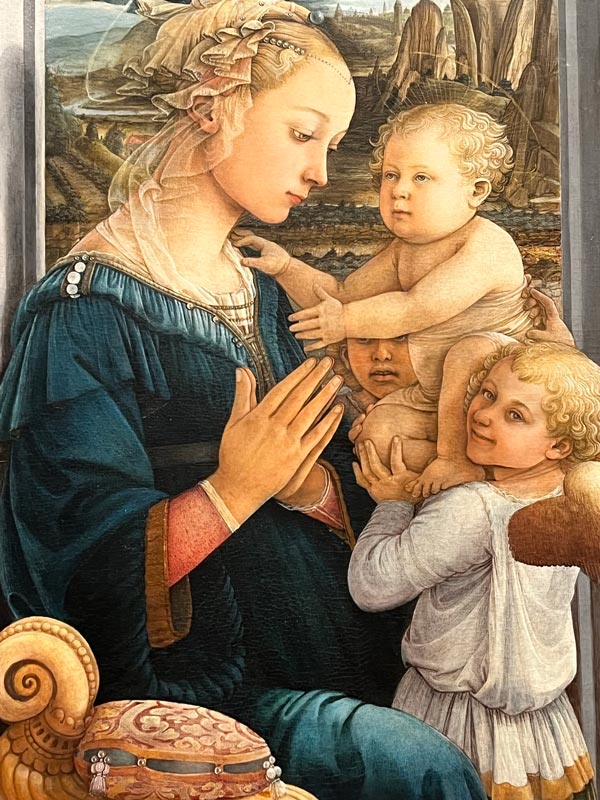
Filippo Lippi (1406 – 1469) was one of many leading Florentine artists patronised by the powerful Cosimo de Medici. He was a former Carmelite monk who left the order after a scandalous love affair with a nun and later became Botticelli’s master.
Lippi’s Madonna doesn’t need a halo or a vase of lilies to assure us of her purity and holiness. She represents heavenly beauty on canvas, an idealised vision of womanhood, radiating tenderness and light.
Some believe that the Virgin’s face is that of Lucrezia Buti, the young nun who became Lippi’s wife.
The composition was widely hailed as a success and was used as a model by many artists, including the young Botticelli.
The Duke & Duchess of Urbino, Piero della Francesca (1475)
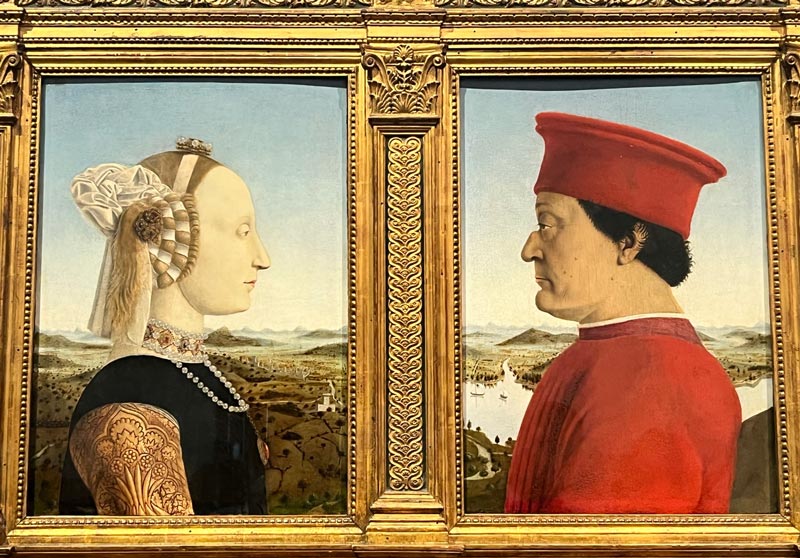
Like Paolo Uccello, Piero della Francesca (1415 – 1492) was a mathematician as well as a painter. It’s not surprising therefore that his painting is characterised by its use of geometric forms and perspective as well as its serene humanism.
During the humanistic Renaissance, it was not only religious figures who were committed to canvas, as this painting demonstrates. This is one of the most celebrated portraits of the Italian Renaissance.
The powerful Duke Federico da Montefeltro (1444-82) was one of the champions of the Italian Renaissance and established his court in Urbino in central Italy. Under his stewardship, Urbino attracted the greatest artists, architects and scholars of the day and became a thriving artistic centre.
His devoted wife, Battista, bore him seven children before the age of 25.
This dual portrait breaks with convention by placing the man on the right. There was a reason for this. As Federico lost his right eye and the bridge of his nose in a tournament, his right side was not his best.
La Primavera, Sandro Boticelli (1478)
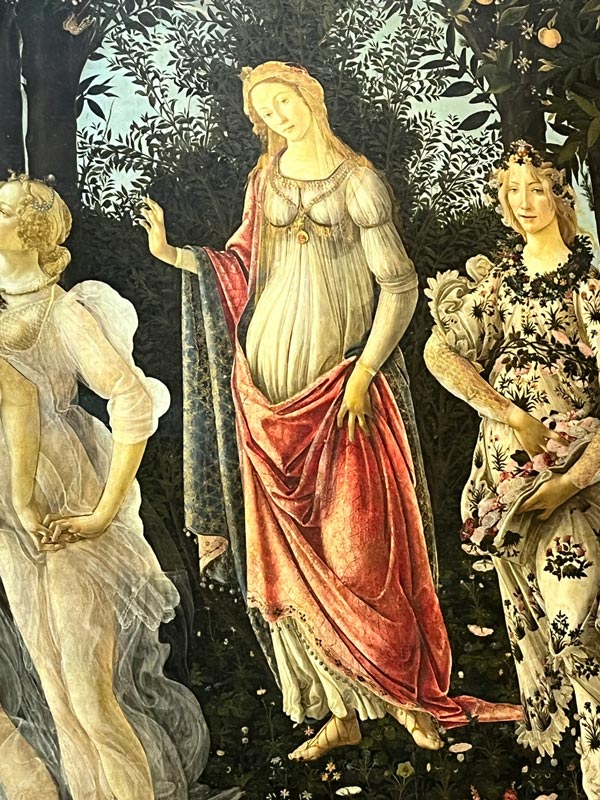
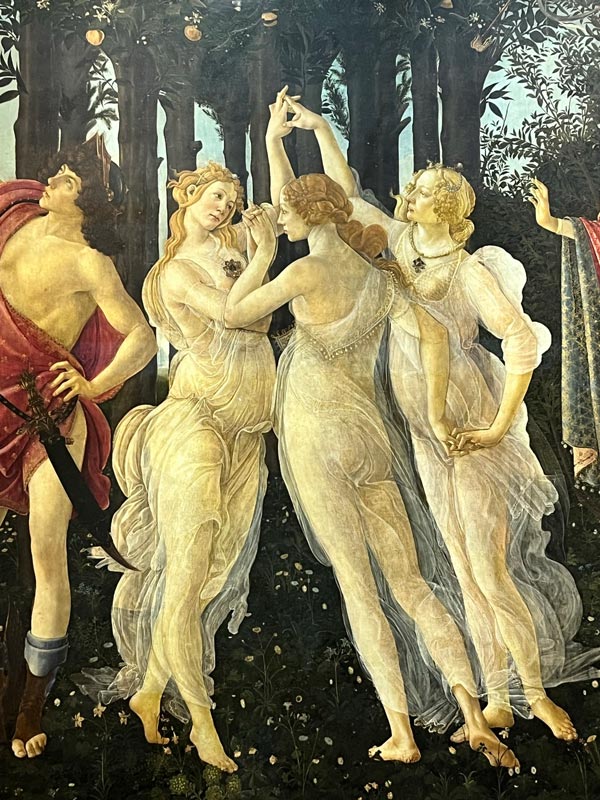
Sandro Botticelli (1445 – 1510) was one of the most popular artists of the Italian Renaissance and the first artist of this period to paint mythologies with the reverence usually reserved for religious themes.
La Primavera is not only one of the most magnificent and famous paintings from the Renaissance, but it is also one of the most discussed paintings in the entire history of art. Although the interpretation of its symbolism is debated, its beauty is beyond doubt.
In a citrus grove, the winds of spring cause a woman to sprout flowers from her lips as she transforms into Flora, or Springtime. To her left are Mercury and the Three Graces dancing around a maypole.
This is a return to the world of Classical Greece. Serene Madonnas are replaced by naked flesh and idealised beauty with a touch of playfulness.
It goes without saying that La Primavera was not commissioned by a church. Instead, it hung on a wall in one of the Medici palaces.
Birth of Venus, Sandro Botticelli (1485)
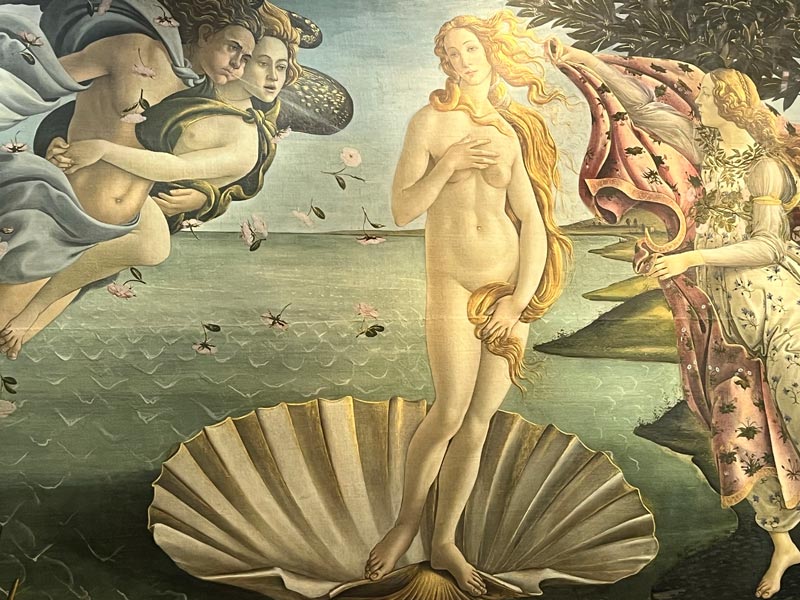
The Birth of Venus is one of the most famous paintings in the history of art. It is thought to have been painted for Botticelli’s patron, Lorenzo di Pierfrancesco de Medici.
Venus, the Greek goddess of love, is blown ashore on a scallop shell by Zephyr, the west wind, whose sweet breath begets flowers. Flora, the goddess of flowers, waits to cover her naked body with a richly patterned robe.
Botticelli was inspired to paint this masterpiece after viewing ancient statues on a trip to Rome. Like La Primavera, the bodies and faces are idealised and the nakedness is innocent rather than erotic.
Madonna of the Magnificat, Sandro Botticelli (1481)
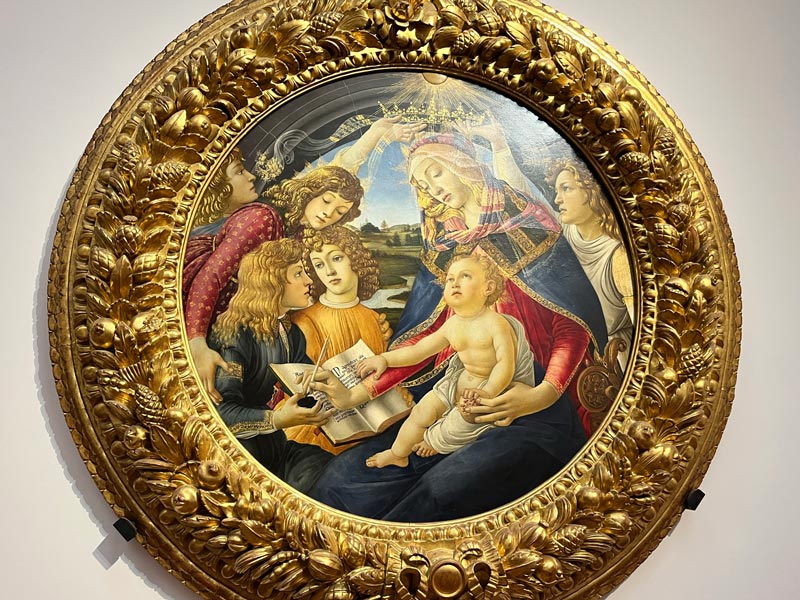
Widely considered to be Botticelli’s most majestic portrayal of the Virgin and Child, this tondo (a circular form of painting) takes its name from the Latin hymn known as the Magnificat. It is also known as the Virgin and Child with Five Angels.
Mary is writing the Magnificat with her right hand, and a pomegranate – a symbol of resurrection and life everlasting – sits in her left hand. Two angels crown her, and the Christ child sits on her lap.
A serene landscape forms a backdrop to the portrait, and the framing creates a division between Heaven and Earth.
La Calunnia, Sandro Botticelli (1495)
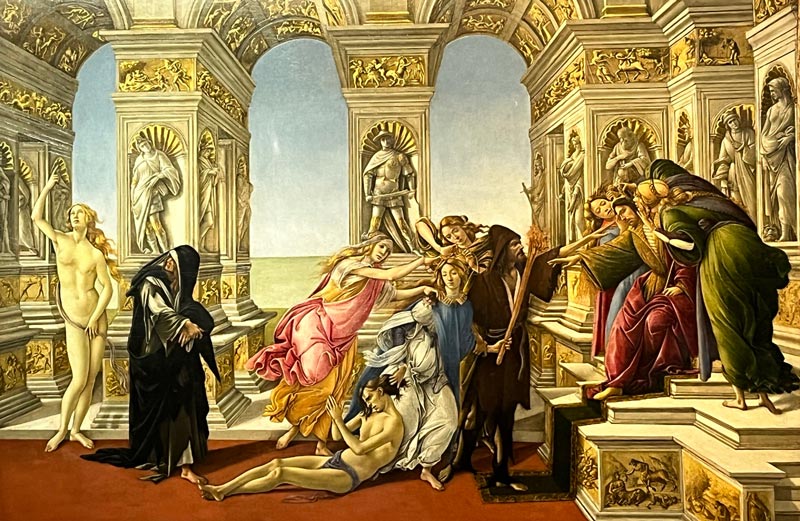
Striking a different tone, La Calunnia heralds the end of the Florentine Renaissance.
A charismatic but fanatical monk called Savonarola turned Florence into a theocracy, denouncing the humanistic culture of the Italian Renaissance and sponsoring “bonfires of the vanities.” Botticelli himself came under the monk’s spell, even burning some of his own paintings.
The setting for this small canvas is a classical Renaissance town, but it is occupied by a ragtag bunch of people. These figures are personifications of vices or virtues or, in the case of the king and victim, represent the roles of the powerful and the powerless.
The Annunciation, Leonardo da Vinci (1475)
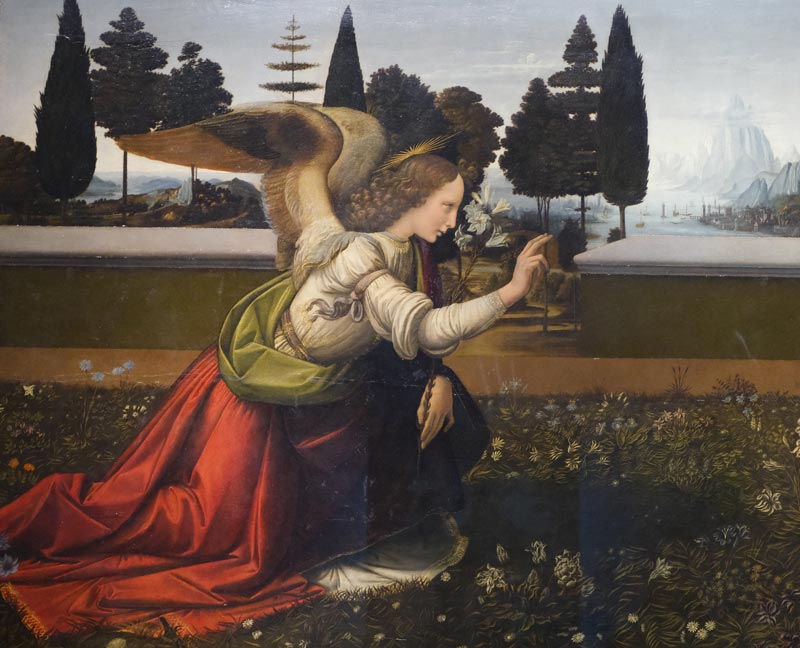
If there is anyone that encapsulates the spirit of the Renaissance it’s Leonardo da Vinci (1452 – 1519). He spent his life in the pursuit of knowledge and was revered for his towering intellect as much as his artistic prowess.
The Annunciation is one of Leonardo’s early masterpieces, painted soon after he became a master in the painters’ guild in Florence.
His love of botanical detail is expressed in the painting’s exquisite carpet of flowers. With his typical scientific fidelity, the angel’s wings are modelled on those of a bird.
Doni Tondo (The Holy Family), Michelangelo (1506)
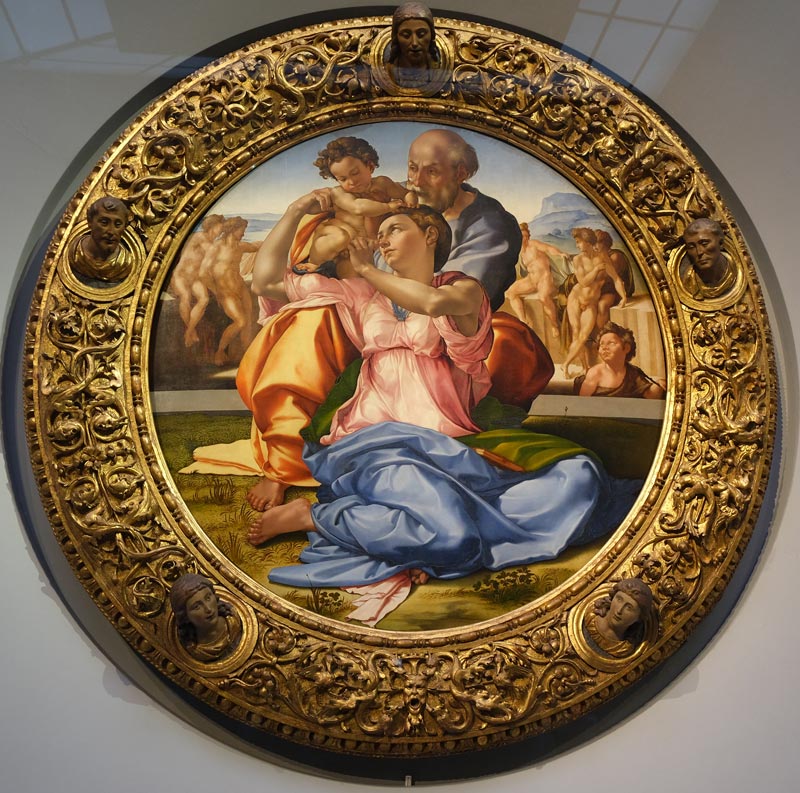
A Florence native, Michelangelo spent much of his long life (1475 – 1564) working for the popes in Rome. He is one of the greatest artists who ever lived and his astonishing career encompassed painting, sculpture, architecture and even poetry.
Painted for a Florentine businessman called Agnolo Doni, this is the only completed easel painting by Michelangelo, made just after he had finished David, one of Florence’s most famous sculptures.
The sculptural influences in this painting are clear. It looks like three groups of statues: The Holy Family itself and two groups of nudes in the background. A young John the Baptist is on the right.
But this is as far removed from a serene Giotto Madonna as you can get. Michelangelo’s Mary is strikingly plain. The artist was not exactly a handsome man and was one of the first painters to recognise beauty in everyday people.
Madonna of the Goldfinch, Raphael (1506)
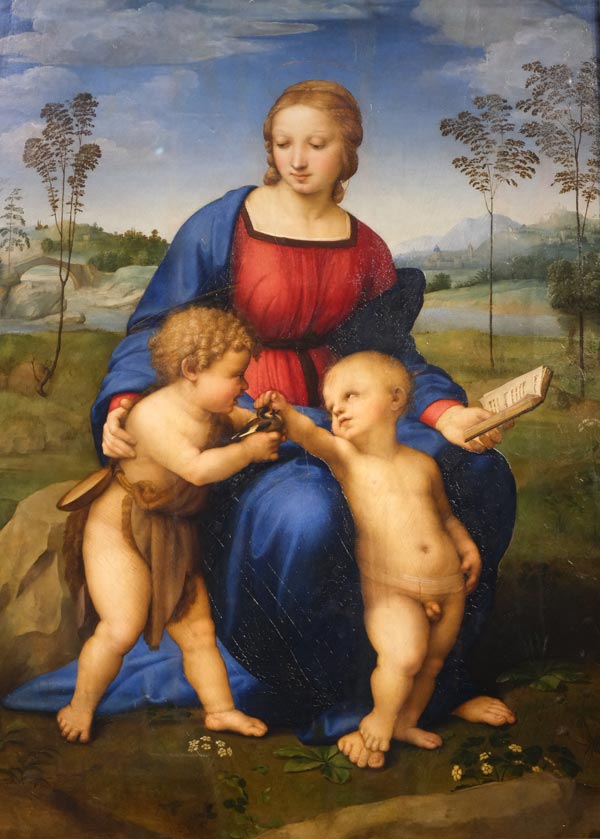
Rafaello Sanzio – Raphael (1483 – 1520) – was born in the city of Urbino and is considered to be the perfect Renaissance artist. Said to be gracious and charming as a man, he was a painter of prodigious talent, known for his beauty of line and colour and harmonic composition.
Raphael’s Madonnas are some of the most enchanting and famous Renaissance paintings. This is one of his greatest.
Mary, dressed in red and blue, sits in front of a pastoral landscape. At her feet are two naked children, Jesus on the right and John the Baptist on the left. The children playing with the bird adds to the tenderness of this scene.
Madonna of the Goldfinch was commissioned for the marriage of Lorenzo Nasi with Sandra di Matteo Canigiani
Angel Playing a Lute, Rosso Fiorentino (1521)
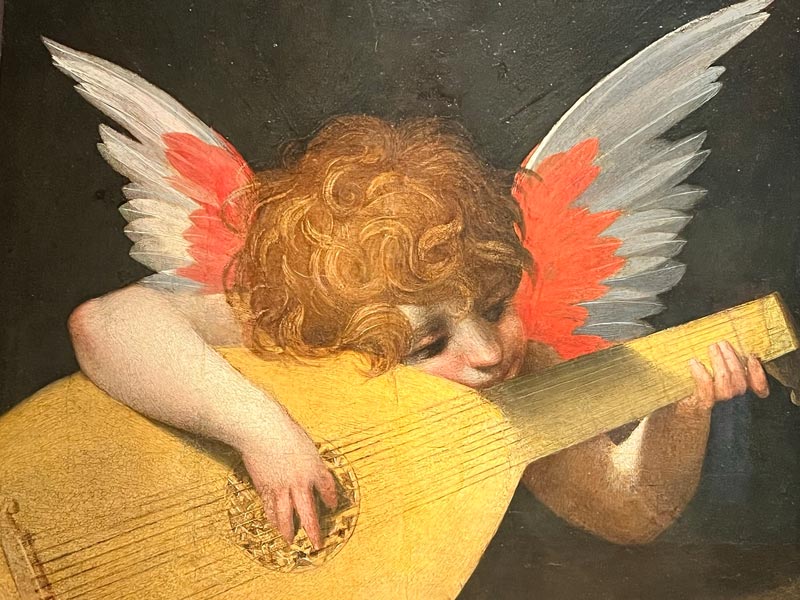
Giovanni Battista di Jacopo (1495 – 1540) owed his nickname – Rosso Fiorentino – to his flaming red hair. This Florence-born artist is best known for his Descent from the Cross altarpiece which hangs in the Pinacoteca Comunale di Volterra.
This famous work of art depicts a cherub plucking the strings of a lute and is probably a fragment of a lost altarpiece. I love the tenderness of this image, the child angel tentatively handling a lute that appears massive by comparison.
Venus of Urbino, Titian (1538)
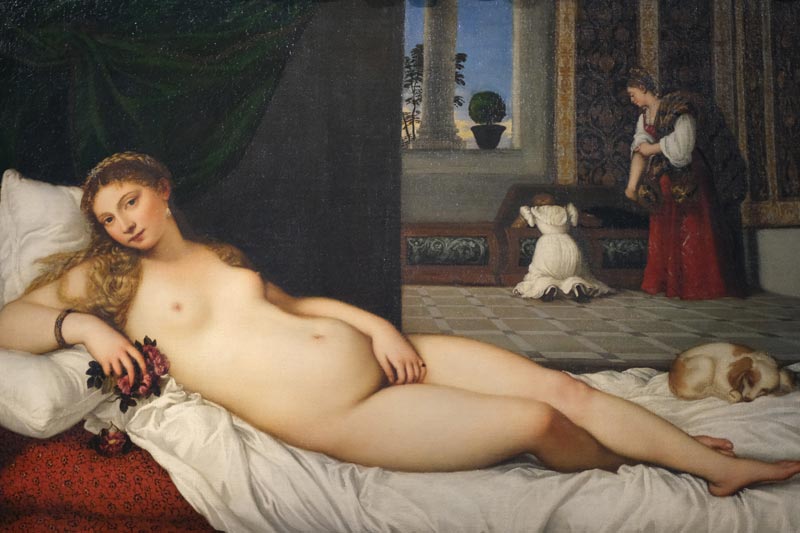
The greatest painter of the Venetian school, Titian (1485 – 1576) did not spread his talents widely. He stuck to painting and left a huge body of work that includes erotic mythologies, moving religious works and some of the greatest portraits ever committed to canvas.
He developed a style that was free, warm and filled with sensual colour, clearly shown in this, his most famous nude.
A young bride is about to be dressed to take part in the celebration of a ritual known in Venice as il toccamano. This was a ceremony during which a young woman would touch the hand of her groom-to-be to express her consent for marriage.
This is a coquettish, almost carnal, Venus. She lies naked on a bed with crumpled sheets, gazing out at the onlooker.
At the foot of the bed, the sleeping dog represents fidelity in marriage. In the background two maids busy themselves.
Venus of Urbino was purchased by Guidobaldo II della Rovere and was taken to Florence as part of the dowry of Vittoria della Rovere, She was the last member of the family and the wife of Grand Duke of Tuscany, Ferdinando II de Medici.
Medusa, Caravaggio (1597)
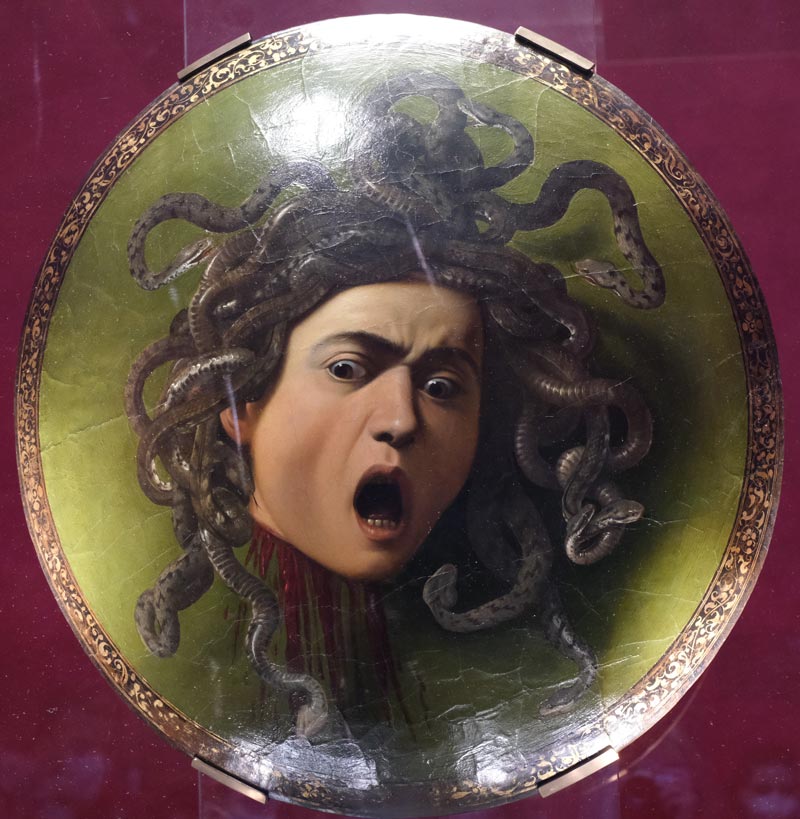
The last of these famous paintings in Florence’s Uffizi Galleries takes us beyond the Renaissance.
Caravaggio (1571 – 1610) is known as much for his short and tempestuous life as for his works of art. His popular – and controversial – paintings were characterised by their dramatic lighting.
Caravaggio’s Medusa was commissioned as a ceremonial shield by Cardinal del Monte, an agent for the Medici family in Rome. This is the second of two versions of the painting.
Medusa was a Gorgon monster, a female creature from Greek Mythology, who had a mane of venomous snakes and a terrifying face that turned those who gazed upon it to stone. She was decapitated by the mythical hero Perseus, who avoided direct eye contact by using a mirrored shield. After Medusa’s death, her decapitated head continued to horrify those who looked at it.
Caravaggio modelled Medusa’s face on himself. Although her head has been chopped off, she remains conscious. Aware that she is hanging between life and death, her open mouth emits a silent scream and her horrified eyes stare out at the viewer.
DID YOU KNOW? The Uffizi is home to one of the best viewpoints in Florence. Just head to the end of the great hallway or stop for a (pricey) coffee in its lovely terrace cafe.
Paintings and Frescoes in the Basilica of Santa Maria Novella, Florence
Santa Maria Novella is one of the most important Gothic churches in Florence. Built by Dominican friars between 1279 and 1357, it is stuffed full of artistic treasures and has peaceful cloisters and a small museum
The Holy Trinity, Masaccio (1427)
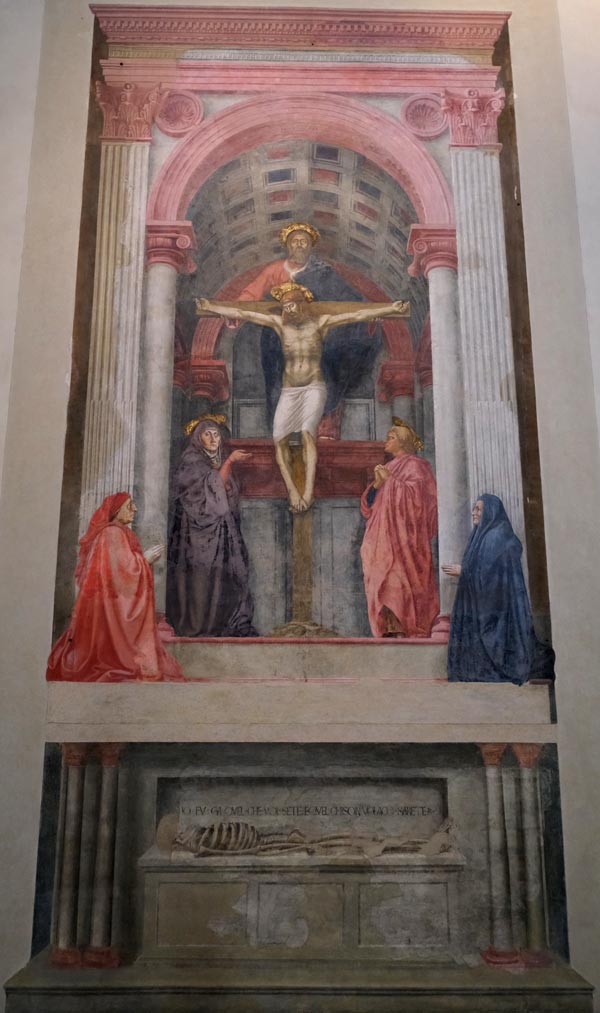
Masaccio (1401 – 1428) is considered to be the first true Renaissance artist, and his use of linear perspective changed the course of Western art. Drawing inspiration from architecture, he created works of stunning realism, with a three-dimensional quality rarely seen at that time.
Painted shortly before his untimely death, The Holy Trinity demonstrates his virtuosity
Brunelleschi’s work on linear perspective and architecture, most famously on the dome of Florence Cathedral, inspired the painting. He may have been involved in its creation.
The Holy Trinity also references ancient Roman triumphal arches and the recently developed linear perspective techniques, with a vanishing point at the viewer’s eye level. Masaccio’s technique is so good that researchers have been able to create a 3D representation of his imaginary space using digital technology.
Although not much is known about the details of the commission, popular theories favour either the Lenzi family or a member of the Berti family.
Fresco cycle in the Cappella Tornabuoni, Domenico Ghirlandaio (1485 – 1490)
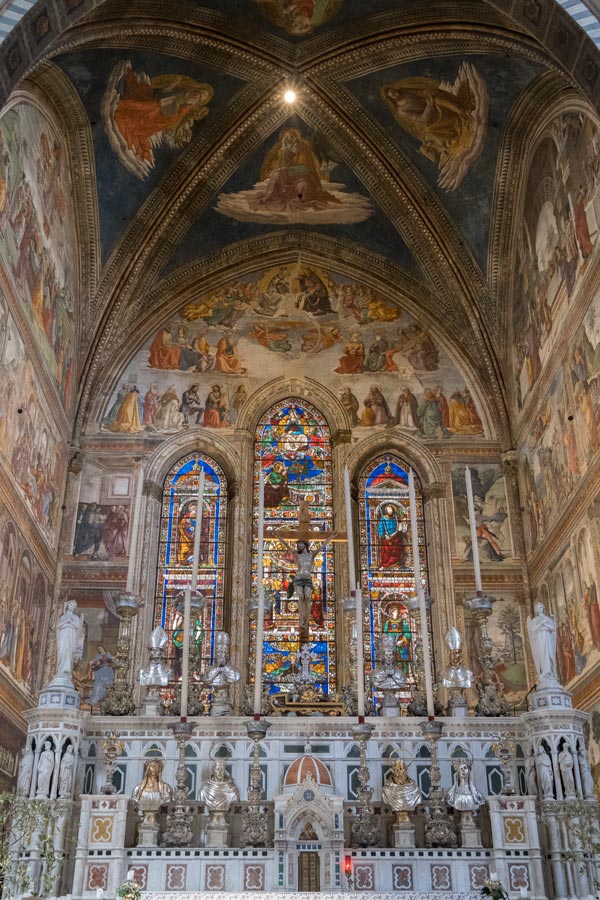
Domenico Ghirlandaio was one of the finest Florentine fresco painters of his day and master to Michelangelo in his formative years. As an apprentice, it is highly likely that Michelangelo was introduced to fresco painting through work on this chapel.
Cappella Tornabuoni is the main chapel in the Basilica of Santa Maria Novella. Its patron, Giovanni Tornabuoni, was one of the wealthiest and most influential men in Florence, linked to the Medici by marriage, business and political interests.
Aided by many assistants, Ghirlandaio painted these frescoes along the chapel’s three walls. The main subjects are the lives of the Madonna and St. John the Baptist and include many historical portraits.
Fresco cycle of the Strozzi Chapel, Filippino Lippi (1502)
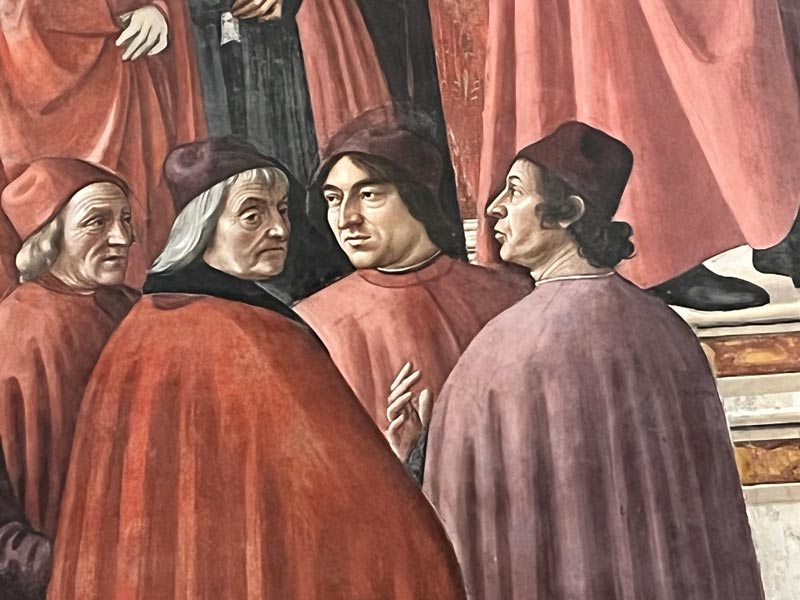
Filippino Lippi (1457 – 1504) was the son of Filippo Lippi and Botticelli’s star pupil. Like his father before him, his work is characterised by sweetness and grace.
Filippo Strozzi the Elder commissioned these frescoes just two years later than those in the Tornabuoni Chapel. However, Filippino Lippi took fifteen years to complete the work.
The tone of Lippi’s fresco cycle is markedly different from that of Ghirlandaio’s. Deeply influenced by the austerity promoted by Savonarola’s fanatical regime, Christians are locked in mortal combat with the pagan world. Profound spiritual anguish is the order of the day.
Spanish Chapel of Basilica of Santa Maria Novella, Andrea di Bonaiuto (1366 – 1367)
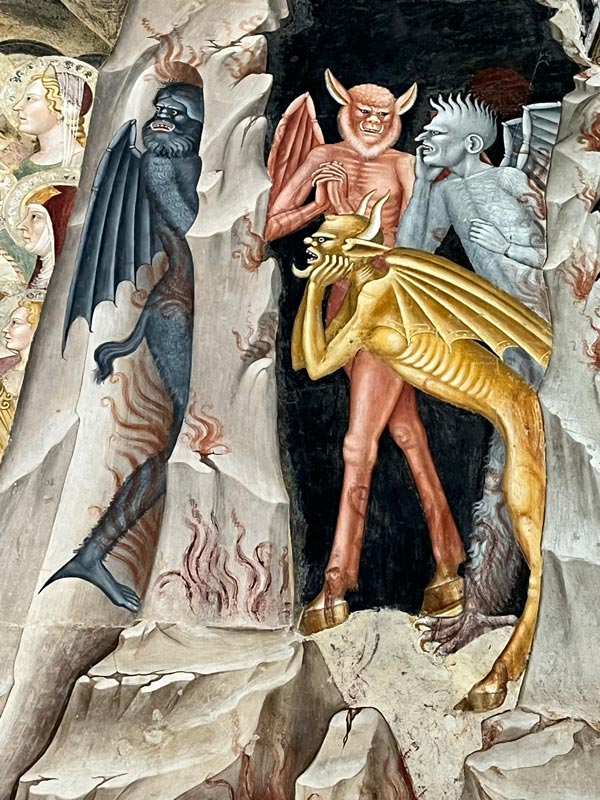
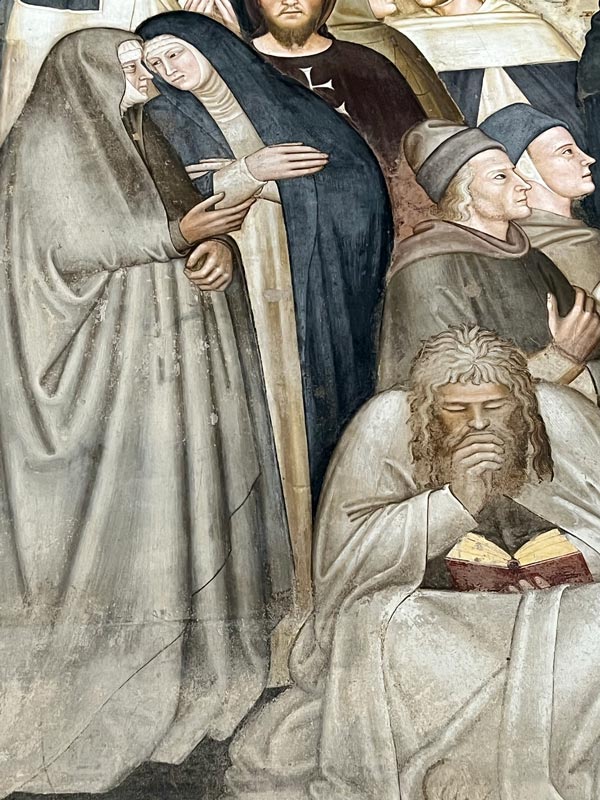
In an annexe of one of the church’s cloisters, Santa Maria Novella’s Spanish Chapel is one of Florence’s lesser-visited jewels. This building dates from the 1350s and served as the chapter house for the Dominican friars of Santa Maria Novella.
Buonamico di Lapo Guidalotti was its patron and he commissioned Andrea di Bonaiuto (Andrea di Firenze) to paint it. It was known as the Spanish Chapel after 1566 when the Dominicans allowed Florence’s Spanish community to use it for worship.
This low vaulted space is entirely covered with frescoes, including the ceiling. The overall theme is salvation through Christ, with a little help from the Dominicans.
Paintings in San Marco, Florence
This former monastery is home to the finest collection of frescoes by the early Renaissance master Fra Angelico (1395 – 1455). He was one of the leading painters of the Early Renaissance in Florence, whom Vasari described as possessing “a rare and perfect talent.”
Fra Angelico was just one famous monk who lived in San Marco. The other was Savonarola, who almost succeeded in bringing down the Renaissance.
The Annunciation, Fra Angelico (1440 – 1445)
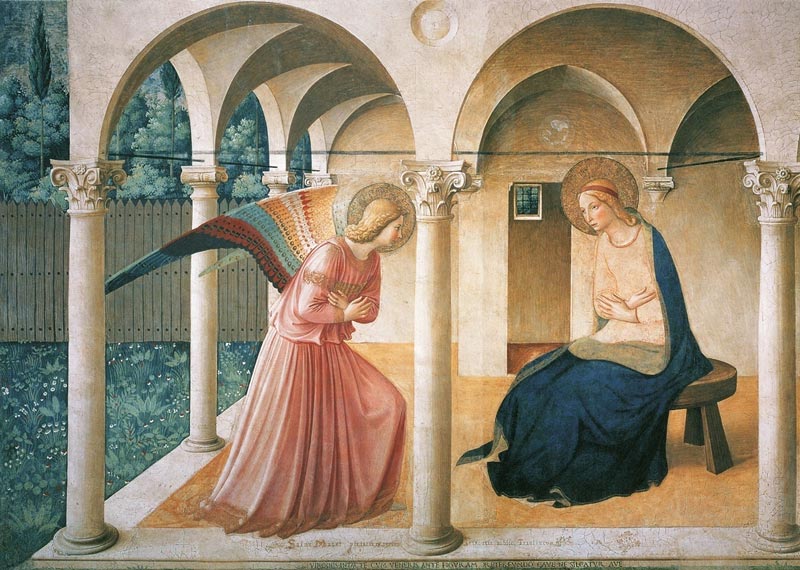
This sublime work by Fra Angelico is one of the most famous paintings in Florence.
Kneeling before Mary, the Angel Gabriel delivers his “the good news” to the Virgin. Look carefully at the angel’s wings. They sparkle thanks to glitter mixed in with the fresco.
Back in the day, the monks of San Marco would gather on this spot for morning prayers.
Savonarola, Fra Bartolomeo (1498)
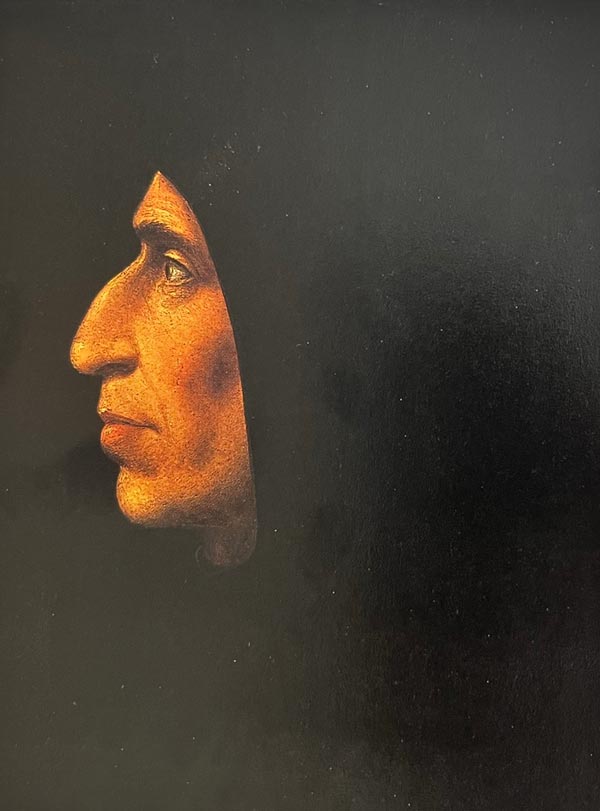
Don’t miss the living quarters of Savonarola if you visit San Marco. In the final cell, there is a display case containing a few pieces of his clothing. It’s safe to say that he didn’t dress for comfort or style.
The most famous portrait of the fanatical monk hangs in Museo San Marco.
Painted by Fra Bartolomeo, also a Dominican monk, this was probably done while Savonarola was still alive. He is mostly hidden, his sharp profile visible under a dark hood.
Famous Florence Artworks in the Pitti Palace
Pitti Palace (Palazzo Pitti), one of the most well-known landmarks in Florence, was home to Cosimo I de Medici (1519 – 1574) and a symbol of the Medici’s power over Tuscany. The palace’s Palatine Gallery is renowned for its Raphael Madonnas and Titian portraits.
The Madonna of the Granduca, Raphael (1506 – 1507)
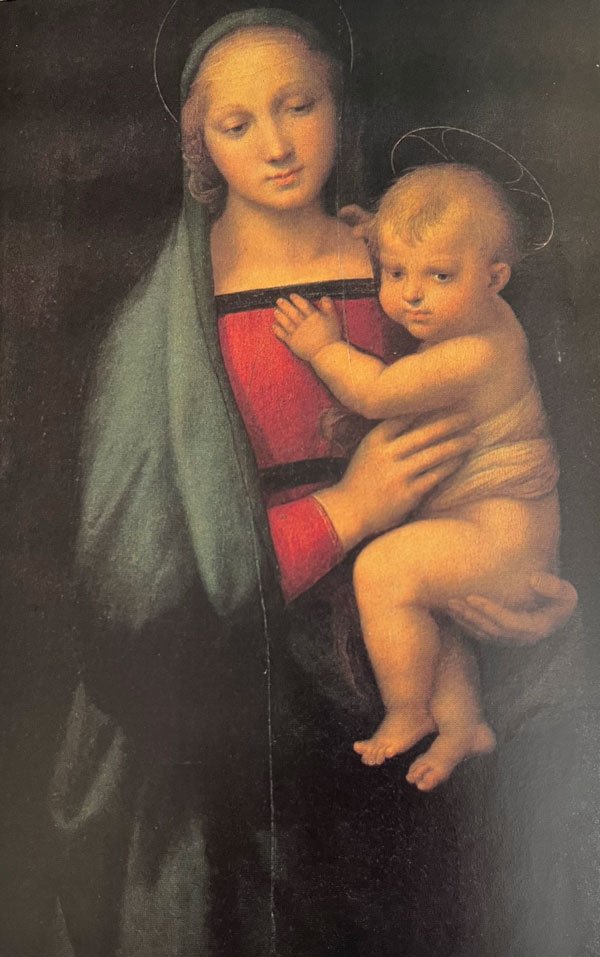
The Madonna of the Granduca is one of Raphael’s most famous paintings
By placing the figures against a dark background, Raphael created a striking image. This is typical of his Madonnas: grace, sweetness and modesty emphasised by soft features and lowered eyelids, gazing tenderly downwards
This painting takes its name from Ferdinand III, Grand Duke of Tuscany (1769-1824) who purchased it for the Pitti Palace between the autumn of 1799 and winter of 1800.
Madonna della Sedia, Raphael (1513 – 1514)
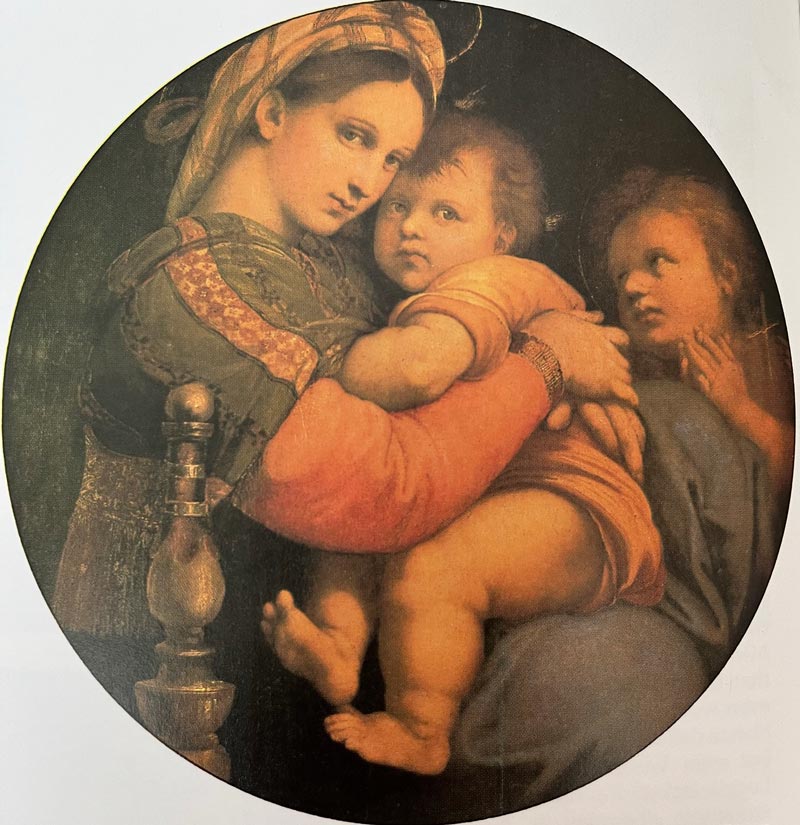
Madonna della Sedia (Madonna of the Chair) demonstrates Raphael’s mastery of the tondo. His colours are unusually vibrant, a mix of red, blue, orange and acid green.
A beautifully dressed Madonna holds the Christ Child as they both look towards the viewer. Saint John the Baptist is on the right looking at the Madonna and Child.
This is one of the most copied works of the 18th and 19th Centuries.
St. Mary Magdalene, Titian (1531-1535)
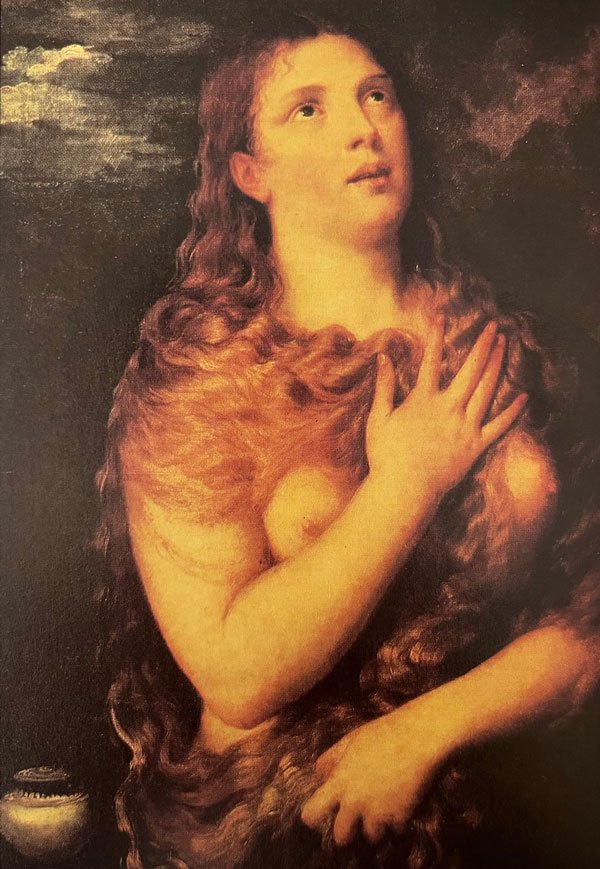
Her eyes cast upwards in an act of worship, this is a bold and erotic treatment of Mary Magdalen. Titian’s penitent prostitute is packed with femininity and has a lush mane of hair that covers her bare breasts (her nakedness symbolises her resolve to strip herself bare of her past).
Titian copied this Mary Magdalene many times in his career. This version is likely to be one of the artist’s oldest versions and it was probably painted for Francesco Maria della Rovere, Duke of Urbino.
The Young Englishman, Titian (1540 – 1545)
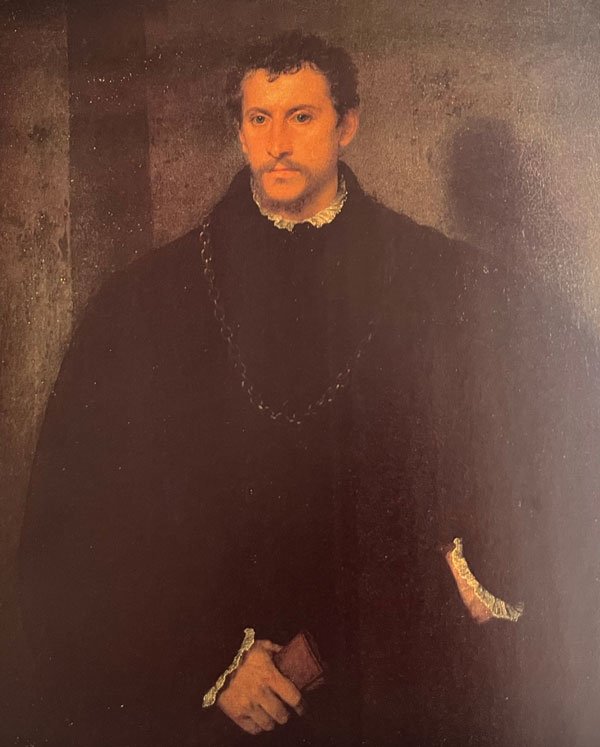
During his lifetime, Titian established a reputation as Europe’s go-to portraitist. With the sitter’s impassive face and piercing grey eyes, this is one of his most arresting portraits. The identity of the handsome aristocrat remains a mystery.
Other Masterpieces for Your Florence Art Bucket List
Frescos in the Brancacci Chapel of Santa Maria del Carmine, Masaccio (1425 – 1485)
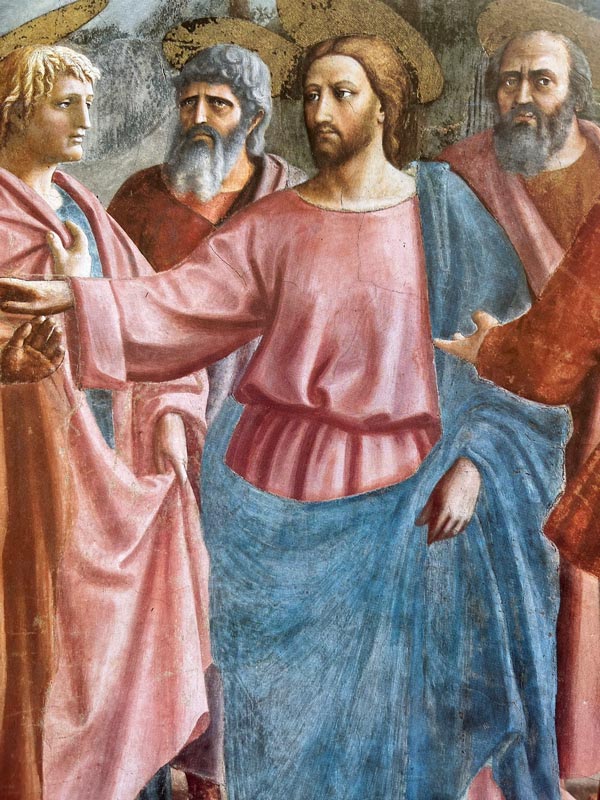
If I were forced at gunpoint to name my favourite paintings in Florence, the Masaccio frescoes in the Brancacci Chapel of Santa Maria del Carmine would be at the top of the list. I try to make my way to this church in the Oltrarno each time I visit.
The Brancacci family were patrons of the chapel from the mid-14th Century until 1780 when it was taken over by the Riccardi. Felice Brancacci commissioned the decorative work in 1424.
But we don’t have just Masaccio to thank for this fresco cycle.
It was designed by Masolino da Panicale, who began work on them with his then-pupil Masaccio. In 1428, Masaccio took over the reins from Masolino, only to die later that same year. More than 50 years later, the remaining parts were completed by Filippino Lippi.
The overall theme is the life of St. Peter, portrayed in vivid colours with Masaccio’s firm grasp of perspective. Viewing the anguish of his Expulsion from Eden is worth the cost of your airfare to Florence alone.
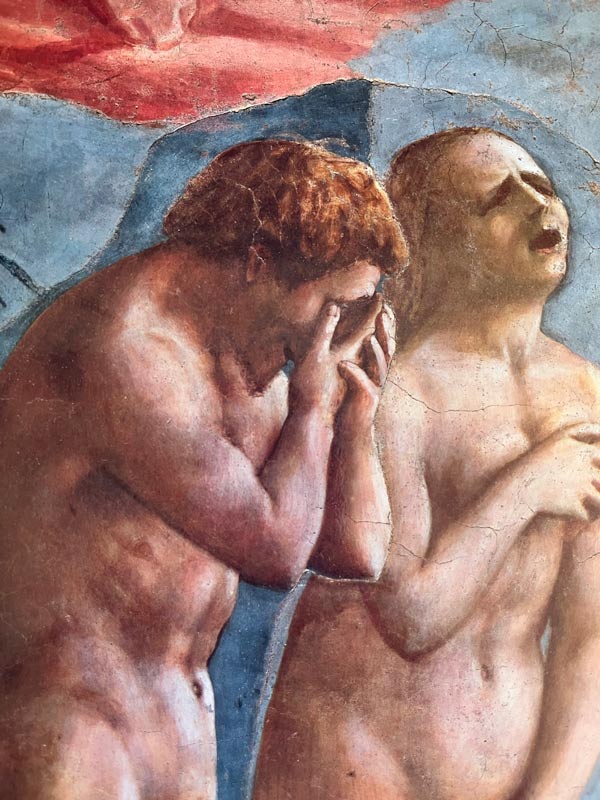
The Journey of the Magi, Benozzo Gozzoli (Medici-Riccardi Palace)
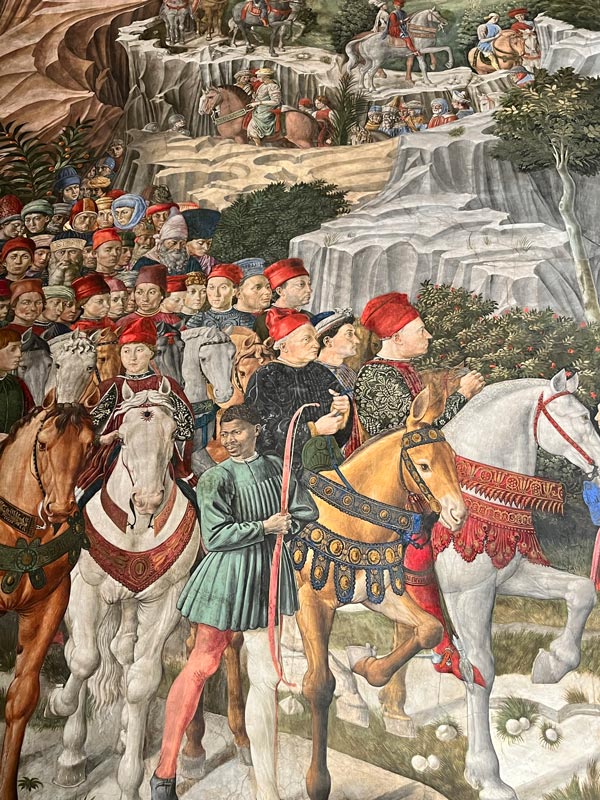
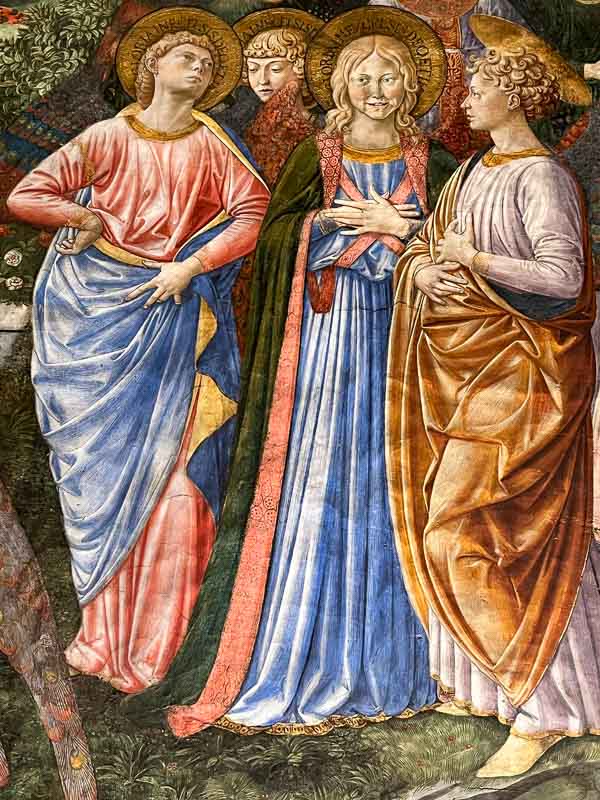
Once the home of Lorenzo the Magnificent (1449 – 1492), ownership of the Medici Riccardi Palace passed from the Medici family to the Riccardi family in the 1700s.
The main draw of the palace is the tiny Chapel of the Magi which contains some vibrant Renaissance gems, among them Benozzo Gozzoli’s fresco cycle, The Journey of the Magi. Gozzoli was a pupil of Fra Angelico and he lent a hand with the decoration of the cells at San Marco
Just look at the fine attention to detail in these festive, vibrant processions that extend across the east, south and west walls of the main room. These three walls were painted in about 150 working days, and each represents one of the Three Kings.
Mosaics of Florence Baptistery (1225 – 1330)
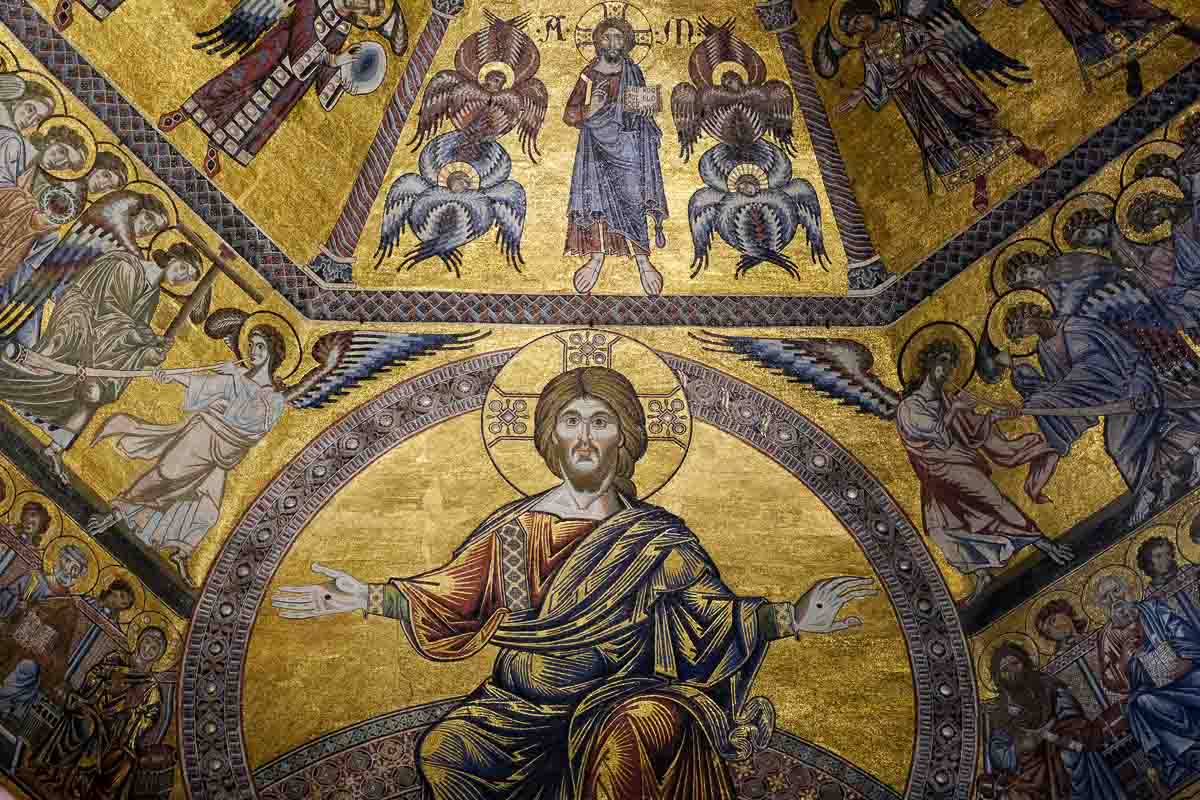
Florence’s Baptistery of St. John is home to one of the most important cycles of medieval Italian mosaics, which cover its internal dome and apses.
This was a cooperative endeavour. Designs were drawn up by major Florentine painters such as Cimabue, Coppo di Marcovaldo, Meliore and the Master of the Magdalen, and created by the best Venetian mosaicists of the day.
These glittering gold mosaics depict biblical scenes, including the Last Judgment, scenes from the life of John the Baptist and Joseph, and stories from Genesis. Taking pride of place above the altar is the figure of Christ the Judge, giving the ultimate thumbs-up or thumbs-down.
The Last Judgement in Florence Cathedral, Giorgio Vasari (1572 – 1579)
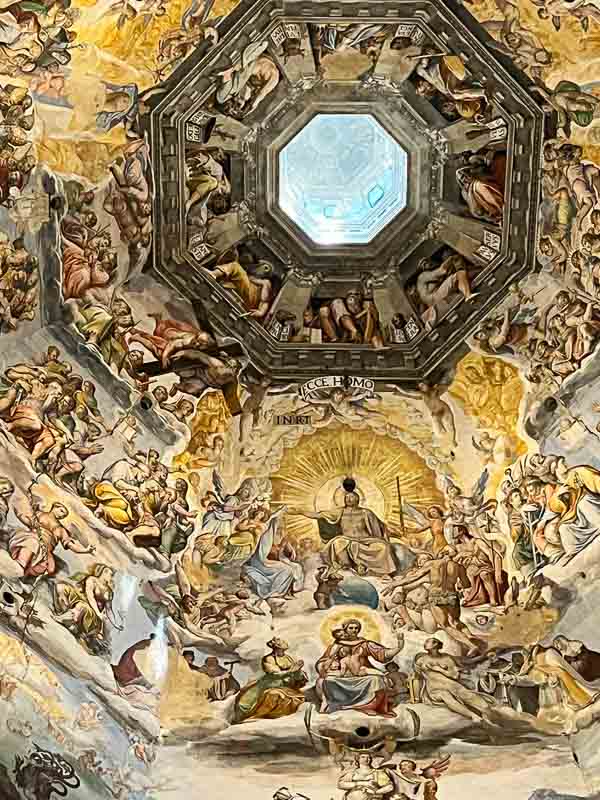
Giorgio Vasari (1511 – 1574) is a towering figure of the Italian Renaissance. An artist and architect himself, he is best known for his biographies of the artists of this period.
In 1572, the Grand Duke Cosimo I de Medici commissioned Giorgio Vasari to paint frescoes on the unfinished dome of the Florence Cathedral. Drawing inspiration from the mosaics in Florence’s Baptistery and from Michelangelo’s Last Judgement in the Sistine Chapel, Vasari arranged groups of figures into six concentric rows, each with a theological theme.
However, Vasari died in 1574, leaving two-thirds of the work incomplete. The mantle was taken up by Federico Zuccari, an artist from Urbino.
To get the best view of the interior of these frescoes, buy a ticket to climb the Cathedral dome.
Life of St Francis at the Bardi Chapel at Santa Croce, Giotto (1317 – 1321)
At the time of updating this article (July 2023), the Bardi Chapel at Santa Croce remains closed for restoration. Consequently, I could not see them on my last visit and you won’t be able to either until the scaffolding comes down in a few years’ time.
But these Giotto frescoes are too important to ignore.
This chapel is dedicated to St. Francis and was one of four chapels patronised by the Bardi, a powerful family of bankers. It dates to the turn of the 14th Century.
It is thought that these decorations would have been commissioned by Ridolfo de’ Bardi.
Giotto condensed the stories from the Life of St. Francis into seven episodes, three per wall, in addition to a panel over the arch at the entrance to the chapel. These are the Apparition at Arles, the Confirmation of the Franciscan Rule, the Death and Ascension of Saint Francis, the Renunciation of Worldly Goods, the Stigmatisation of Saint Francis, the Trial by Fire and the Vision of the Ascension of Saint Francis.
And That’s a Wrap!
I hope this whistle-stop tour through these famous paintings will help you get the most out of your time in Florence. If this has been helpful, you may enjoy some of my other guides to art in Italy:
- 20 Famous Sculptures in Florence That You Must See
- 11 Places to Find the Art of Michelangelo in Florence, Italy
- Visiting Doria Pamphilj, Rome: An Essential Guide for Art Lovers
- Visiting the Scrovegni Chapel in Padua: Giotto’s Masterpiece

About Bridget
Bridget Coleman is a Renaissance fan girl and has been travelling the globe for more than 30 years. She has visited 70+ countries, most as a solo traveller.
Articles on this site reflect her first-hand experiences.
To get in touch, email her at hello@theflashpacker.net or follow her on social media.

